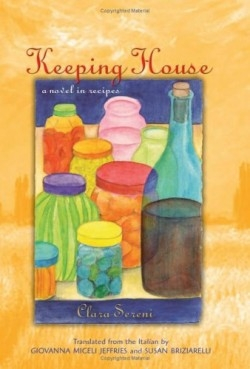Keeping House
A Novel in Recipes
First published in 1987, and now released as part of the SUNY Press series “Women in Translation,” this book is a cornerstone of modern Italian feminist literature. Politics and culture are viewed through the life of one woman, particularly the food she eats and prepares. The author’s narrative moves beyond simple gastronomic recollection to explore how food can mediate the tensions of evolving national politics, gender roles, religious and cultural identity, and life in an illustrious Jewish Italian family.
The book is structured like a classic cookbook, with each chapter representing a course in a meal. Additional chapters discuss how to cook for a baby, plus preserving and canning. While the external structure is linear, the internal flow of the narrative is associative and circular. Each bundle of recipes is tied to a memory or two in which the described meal serves as a way to enter the moment.
The recipes are direct and functional, such as the one for Milk Soup. The ingredients are milk, rice, butter, Parmesan, and salt. No quantities are given. The instructions are: “I cook the rice in the milk with the salt and then dress it with the butter and cheese.” The soup section involves Milk Soup, Onion Soup, Cream of Potato, and Stracciatella—the comforting soups of childhood, which serve primarily as a sensory preparation for a story of a tender moment between Sereni as a young girl and her father.
Sereni includes the recipes not as prescriptions, but as conversations. In the pedestrian nature and inexactitude of the ingredients and preparation method, she creates commonality with her initial audience. For the non-Italian, it is learning a world through the mouth. The recipes serve up a constellation of new flavors: nettles, semolina gnocchi, and the prevalence of Parmesan.
Sereni’s style is spare, but lyric; one might say handsome. She describes her oldest sister as “the priestess of a family life that I had never known” and her youngest sister as having “a head full of curls, big eyes and the soft, athletic body of a Sabra soldier.” The episodic quality of the narrative lends it a quiet, meditative tone that works well with the larger concept of self-discovery.
The translation is seamless. The translators acknowledge the difficulties and compromises of their task, which underlines their sincerity and reliability. The comprehensive introduction by Miceli Jeffries places the novel in historical and literary context, and helps the reader understand its role in Sereni’s larger body of work. “Keeping House established the author as a major contemporary and original voice,” she writes, “a voice in which a generation of women who were active protagonists of the struggles and actions of the late sixties’ protest movements could recognize themselves.”
Keeping House will quickly find a home in college survey classes, though it might not be easily accessible to a general audience because of the many oblique cultural references. Mindful of this, the translators provide notes on the most crucial points. The connection will universally be made through the narrative voice and recipe-swapping structure, so intensely humane that even idiosyncratic cultural references feel immediate and remembered.
Miceli Jeffries teaches Italian at the University of Wisconsin—Madison, where she is also involved in promoting the teaching of Italian in Wisconsin schools, and edited Feminine Feminists: Cultural Practices in Italy. Briziarelli, who holds a Ph.D. in Italian with a focus on modern literature from Yale, teaches Italian at the University of San Diego and wrote Enrico Annibale Butti: The Case of the Minor Writer.
Beyond authoring ten books, including Passami il Sale (Pass the Salt) in 2002, which won three Italian literary prizes, Sereni has been very involved with politics and social issues. From 1995 to 1997, she was deputy mayor of Perugia, where she currently lives. She writes for L’Unit and il manifesto, major leftist newspapers, and is president of City of the Sun, an organization devoted to developmentally disabled people.
Sereni sees the table as the nucleus of life; in mining her ever-evolving relationship with it, she approaches an understanding of herself. Towards the end of the book she writes, “And so my aerial self sinks into the jars, into the liqueurs … into the freezer. Because in my life, … keeping house can also mean a little warm place.” Keeping House is a dense and rewarding read, which will merit various revisits as readers grow in their own understanding of hearth and self.
Reviewed by
Naomi Millán
Disclosure: This article is not an endorsement, but a review. The publisher of this book provided free copies of the book to have their book reviewed by a professional reviewer. No fee was paid by the publisher for this review. Foreword Reviews only recommends books that we love. Foreword Magazine, Inc. is disclosing this in accordance with the Federal Trade Commission’s 16 CFR, Part 255.

